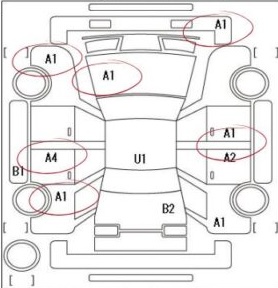When you look at a Japanese auction sheet, you might see codes like A1, A2, A3, or A4 next to the word “scratch.” These codes tell you how big or serious the scratches on the car are. Think of them like a report card for the car’s outside condition.
In this article, we will explain what each of these codes means in very simple words. Whether you are new to buying cars or just want to learn, this guide will help you understand scratches like an expert!
What Are Scratch Codes?
A1, A2, A3, and A4 scratches are part of a system used by Japanese car inspectors to describe the size and visibility of scratches on a vehicle. This system helps buyers quickly understand the condition of the car’s paint and body.

Breaking Down the Codes
1. A1 Scratch: Small Scratch
- What it means: A very tiny scratch that is hardly noticeable.
- What it looks like: Like a light mark you might make with a sharp pencil on paper.
- How to fix it: Often can be polished away easily. Doesn’t need paint.
- Importance: Not a big deal. Many used cars have A1 scratches.
2. A2 Scratch: Scratch
- What it means: A clear scratch that you can see easily.
- What it looks like: Like a deeper line on the car’s paint. You might feel it with your fingernail.
- How to fix it: Might need light polishing or touch-up paint.
- Importance: Common on used cars. Shouldn’t affect the car’s value much.
3. A3 Scratch: Big Scratch
- What it means: A large and obvious scratch.
- What it looks like: Like a clear cut in the paint. You can easily see it from a few steps away.
- How to fix it: May require repainting the scratched area.
- Importance: Could lower the car’s value. You should check if it’s only on the surface.
4. A4 Scratch: Very Large and Noticeable Scratch
- What it means: A very big and deep scratch that stands out.
- What it looks like: Like a major mark that might have gone through the paint to the metal.
- How to fix it: Will likely need professional repainting.
- Importance: Can significantly reduce the car’s value. Might be a sign of poor care.
Why Should You Care About These Scratch Codes?
Understanding A1 A2 A3 A4 scratches helps you:
- Know how much the car might cost to repair.
- Decide if the car is worth buying.
- Avoid surprises after you buy the car.
For example, a car with many A3 or A4 scratches might need more money spent on repairs.
How to Check for Scratches Yourself
Even if the auction sheet says A1 A2 A3 A4 scratches, it’s smart to look at the car’s photos closely. Here’s how:
- Zoom in on the areas mentioned in the report.
- Look for light reflections—scratches often break the smooth line of light.
- Ask for more pictures if you are unsure.
Final Tips for Buyers
- A1 and A2 scratches are normal on used cars.
- A3 and A4 scratches should make you look closer and maybe ask for a lower price.
- Always use a verification service like JP Sheets to get the real auction sheet.
Now you understand what A1 A2 A3 A4 scratches mean! Remember, knowing these codes can help you choose a better car and save money.
If you need help reading an auction sheet, visit JP Sheets for accurate and easy-to-understand reports!